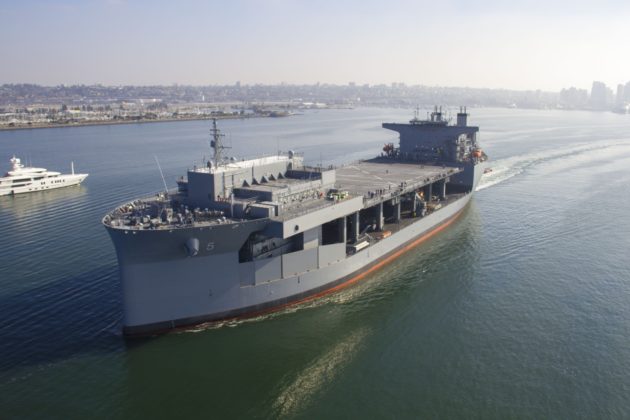By Megan Eckstein
ARLINGTON, Va. – The Navy will now commission all of its Expeditionary Sea Base ships to allow them to conduct a broader and more lethal mission set, compared to original plans for them as Military Sealift Command ships with a USNS designation.
The USS warship designation will now allow these platforms to move beyond transporting special forces, mine countermeasures teams or Marines to actually employing their lethal capabilities – pushing SOF teams ashore for operations, blowing up a mine in the water, launching helicopters for strikes, and more.
The Navy originally planned to operate the ships as USNS support ships under MSC, with the ability to temporarily commission them as warships if needed for a specific operation. When USS Lewis B. “Chesty” Puller (ESB-3) deployed to U.S. 5th Fleet in 2017, the Navy decided to commission that one seabase as a warship while en route to the Middle East due to expected missions and conditions in that particular region.
The decision now applies to the entire class.
“They were initially envisioned to be USNS ships, but we already commissioned Puller, and we’re going to commission Woody Williams here in another couple weeks or so, and then (ESB) 5 will be commissioned at some point in the near future,” Program Executive Officer for Ships Rear Adm. Bill Galinis said last week at the annual Surface Navy Association conference. He noted the future USS Hershel “Woody” Williams (ESB-4) was finishing its post-shakedown availability maintenance period in Norfolk, Va., ahead of a deployment later this year, and that the future USS Miguel Keith (ESB-5) delivered in November and was undergoing post-delivery trials now off the West Coast.
“This re-designation provides combatant commanders greater operational flexibility to employ this platform in accordance with the laws of armed conflict,” Navy spokesman Lt. Tim Pietrack told USNI News.
“The Secretary of the Navy approved the commissioning of all ESBs following feedback from the employment of ESB-3 and expected employment of subsequent ships of the class. Prior to commissioning, the ESB class was limited to defensive actions during times governed by the laws of armed conflict. Post commissioning, these ships have greater mission flexibility throughout the [range of military operations].”
The expeditionary mobile base platform ship USS Lewis B. Puller (ESB-3) transits the Strait of Hormuz on Oct. 22, 2018. Puller is deployed to the U.S. 5th Fleet area of operations in support of naval operations to ensure maritime stability and security in the Central Region, connecting the Mediterranean and the Pacific through the western Indian Ocean and three strategic choke points. US Navy photo
USNI News understands that the rest of the ESB class will adopt the same manning model as Puller did after its commissioning: a hybrid crew with blue and gold uniformed crews that rotate in and out – each led by an O-6 Navy captain and including about five officers and 96 enlisted sailors to support warfighting operations – and about 44 civilian mariners from MSC to operate and maintain ship systems.
A Navy spokesman told USNI News in 2017 that the Puller commissioning decision was made “because of the nature of the evolving threats in the region” and that the “permanent conversion to USS reduces any ambiguity of ESB-3’s status and eliminates the administrative distraction that a temporary conversion creates while streamlining the command and control process.”
Though 5th Fleet was at the time considered the likeliest place where the ship could need these offensive capabilities, Williams is heading to U.S. 6th Fleet, where activities from the Russian military and Russian-backed forces are leading to heightened tensions. The future USS Miguel Keith (ESB-5) will likely head to U.S. 7th Fleet, where aggressions in the South China Sea, Taiwan Strait and other areas are also increasing.
About Megan Eckstein
Megan Eckstein is the deputy editor for USNI News. She previously covered Congress for Defense Daily and the U.S. surface navy and U.S. amphibious operations as an associate editor for Inside the Navy.


Leave a Reply
You must be logged in to post a comment.